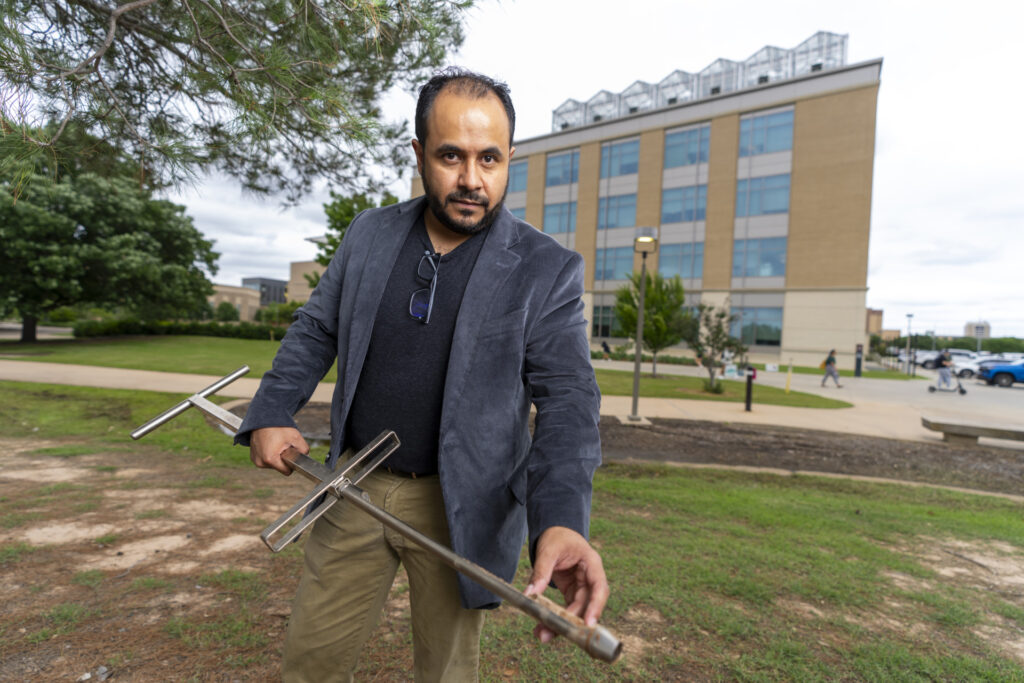Engineering environmental excellence in the next generation
Jorge Arreola Vargas inspires students with hands-on learning
At Texas A&M University, Jorge Arreola Vargas, Ph.D., is teaching students how some of the tiniest organisms on Earth can have a planet-wide impact.

Vargas is an instructional assistant professor who joined the Texas A&M College of Agriculture and Life Sciences Department of Plant Pathology and Microbiology last October. But his passion for bioremediation — the process of cleaning the environment by using microbes to break down contaminants — began while pursuing his undergraduate degree in biochemical engineering in Mexico.
“My undergraduate thesis was my first experience working in a lab, and my project involved producing ethanol from potato waste,” Vargas said. “I fell in love with the idea of biofuels and how microbes can transform waste into products we can use in real life.”
Cleaning up water
Most of Vargas’ research has involved the remediation of water.
After earning his doctorate in environmental sciences from the Potosino Institute for Scientific and Technological Research, Vargas was a professor of environmental engineering at a university in Jalisco, Mexico.
In Jalisco, the Mexican state where almost all the country’s tequila is produced, he worked closely with tequila manufacturing companies to generate technologies for treating wastewater and preventing contamination of nearby rivers.
“When tequila is produced, it generates a lot of waste,” Vargas said. “After fermentation of the agave, it goes through a distillation process to recover the alcohol in the tequila. But, for every one liter of tequila produced, there are around 10 liters of highly contaminated wastewater.”
He later worked on similar projects as a postdoctoral researcher in the Department of Plant Pathology and Microbiology, producing biofuels and bioplastics from different waste products and collaborating on research projects using microbes to remove microplastics from water — a growing concern in environmental science.
Learning by doing

While he still collaborates with colleagues in Mexico and other scientists within Texas A&M AgriLife Research, his primary focus shifted from research to teaching after taking his new position at Texas A&M.
His classes include Sampling and Environmental Monitoring, Biotechnology for Biofuels, U.S. Environmental Regulations, and Microbial Processes in Bioremediation. He follows a teaching philosophy based on the use of real-world examples, discussions of recent scientific breakthroughs and an active learning approach.
“I really enjoy using active learning,” he said. “Direct instruction, like lecturing, is important for covering new topics, but once the students understand these concepts, I like them to see how to apply this new knowledge in real settings.”
In addition to teaching students about the mechanisms involved in removing contaminants from elements like soil and water, Vargas has his students read and discuss research papers and case studies. They also get the chance for hands-on learning through simulated field expeditions, where students head outside to collect soil samples.
“We simulate contaminated soil, and the students have to design a sampling approach,” Vargas said. “It’s very fun. The students learn how different approaches can be applied in a career setting, and they use real equipment to take samples, practice storing them in labs, and sometimes even perform analyses on the samples.”
Emerging environmental issues
Modern bioremediation began in the 1960s and has evolved into a widely accepted method for eliminating pollutants from the environment, such as purifying water affected by oil spills or soil contaminated by waste disposal.

However, the emerging attention to microplastics and per- and polyfluoroalkyl substances, also known as PFAS or “forever chemicals” because of their resistance to degradation, signifies the need for new methods to remove contaminants.
“These compounds have very strong bonds between fluorine and carbon that make them very hard to degrade,” Vargas said. “For many contaminants, the technology to break them down is already established. But these emerging contaminants will have a lot of challenges to them.”
Looking forward, Vargas believes the answer to these stubborn and abundant contaminants lies in discovering new microbes capable of breaking down these substances or modifying metabolic pathways to enable currently used microbes to degrade them.
Though Vargas is optimistic about the current state of research and other trends in the field of bioremediation, such as the transition from fossil fuel-based plastics into bioplastics, he’s also aware that the work will never be complete. As new products and processes evolve, they will inevitably bring about new contaminants to address, which is why he hopes his teaching will strongly impact students.
“I really love to talk to my students about these microbes and the amazing ways they can be used,” he said. “Even if you don’t use them to produce biofuels, they can use their complex metabolism to degrade contaminants and clean water or soil. That’s very fascinating to me. And I try to show that passion to my students so they can be inspired to investigate on their own and fall in love with this world of microbes too.”





